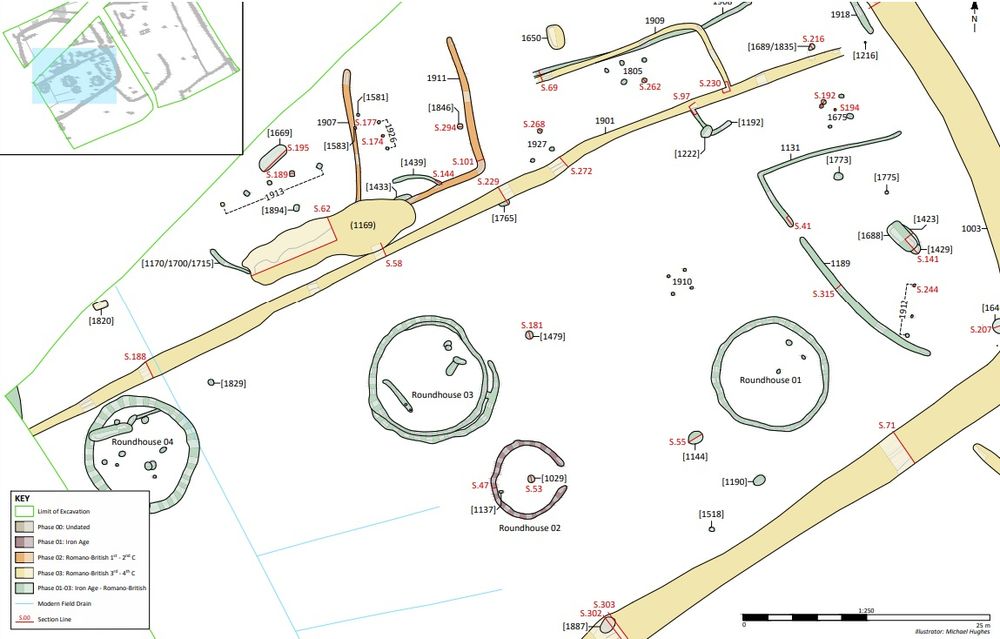
"Derventio, the Little City. A small town in the Roman north. Dr Steve Malone, York Archaeology"
Derbyshire Archaeology Day - Sat 31 Jan at the Winding Wheel, Chesterfield
chesterfieldtheatres.co.uk/shows/derbys...

"Derventio, the Little City. A small town in the Roman north. Dr Steve Malone, York Archaeology"
Derbyshire Archaeology Day - Sat 31 Jan at the Winding Wheel, Chesterfield
chesterfieldtheatres.co.uk/shows/derbys...
A Roman well (down the steps on the left) and the padstones of a colonnaded building, preserved outside 49-51 Marcus Street, Derby. Excavated 1971, the well is in situ but the padstones were moved. Go see it!
More info in DAJ here: archaeologydataservice.ac.uk/archives/vie...


A Roman well (down the steps on the left) and the padstones of a colonnaded building, preserved outside 49-51 Marcus Street, Derby. Excavated 1971, the well is in situ but the padstones were moved. Go see it!
More info in DAJ here: archaeologydataservice.ac.uk/archives/vie...

Iron Age to 350AD - enclosure ditch, roundhouses divided off from 'stuff', pottery production from early 1C. Interesting how the settlement form persists unaltered over maybe 400 years.



Iron Age to 350AD - enclosure ditch, roundhouses divided off from 'stuff', pottery production from early 1C. Interesting how the settlement form persists unaltered over maybe 400 years.
This beautiful small Neolithic edge-ground flint axe - only 10cm long - was found in Sparrowpit, High Peak in 2001, together with flakes, blades and scrapers from both later Mesolithic and Neolithic periods.
her.derbyshire.gov.uk/Monument/MDR...
#Derbyshire #archaeology #Neolithic


This beautiful small Neolithic edge-ground flint axe - only 10cm long - was found in Sparrowpit, High Peak in 2001, together with flakes, blades and scrapers from both later Mesolithic and Neolithic periods.
her.derbyshire.gov.uk/Monument/MDR...
#Derbyshire #archaeology #Neolithic
#PhotoFriday #EYAReligion/Spirituality

#PhotoFriday #EYAReligion/Spirituality






Some nice community-led archaeology on the site of Glapwell Hall - 17C on the possible site of a medieval chapel.
We need some help identifying the decorative mount - is it ormolu (maybe from the hall itself?) or just a later reproduction. Any historic furniture experts out there?



Some nice community-led archaeology on the site of Glapwell Hall - 17C on the possible site of a medieval chapel.
We need some help identifying the decorative mount - is it ormolu (maybe from the hall itself?) or just a later reproduction. Any historic furniture experts out there?
To learn about the Fund and to apply: www.cardfund.org
To learn about the Fund and to apply: www.cardfund.org
"In the Shadow of the Crooked Spire: Recent excavations at Rykneld Square, Chesterfield. Graham Murray & John Thomas (ULAS)"
Tickets here: chesterfieldtheatres.co.uk/shows/derbys...
If we're lucky there might even be a site tour ...
bsky.app/profile/mart...
"In the Shadow of the Crooked Spire: Recent excavations at Rykneld Square, Chesterfield. Graham Murray & John Thomas (ULAS)"
Tickets here: chesterfieldtheatres.co.uk/shows/derbys...
If we're lucky there might even be a site tour ...
bsky.app/profile/mart...
#archaeology #Derbyshire @derbyshirearch.bsky.social


#archaeology #Derbyshire @derbyshirearch.bsky.social
Some lovely Early Bronze Age arrowheads and scrapers from fieldwalking near Aldwark
We don't do enough fieldwalking these days (kudos to ARS Ltd for this one) - on an unploughed site topsoil lithics can capture activity patterns on a landscape scale - hunting, settlement, ceremonial

Some lovely Early Bronze Age arrowheads and scrapers from fieldwalking near Aldwark
We don't do enough fieldwalking these days (kudos to ARS Ltd for this one) - on an unploughed site topsoil lithics can capture activity patterns on a landscape scale - hunting, settlement, ceremonial
If you've never visited St. Wystan's in Repton before - deep below the surface - that first glimpse of the C9th Saxon crypt is quite something.

If you've never visited St. Wystan's in Repton before - deep below the surface - that first glimpse of the C9th Saxon crypt is quite something.
Talks include:
"Rowtor Rocks: prehistoric art and ritual in the White Peak"
Prof. George Nash and Anna Clark of the Derbyshire Rock Art Group
A special one, this - some stunning new rock art finds at Rowtor!
Tickets here: chesterfieldtheatres.co.uk/shows/derbys...


Talks include:
"Rowtor Rocks: prehistoric art and ritual in the White Peak"
Prof. George Nash and Anna Clark of the Derbyshire Rock Art Group
A special one, this - some stunning new rock art finds at Rowtor!
Tickets here: chesterfieldtheatres.co.uk/shows/derbys...
Saturday 31st January 2026, Winding Wheel Theatre, Chesterfield
Tickets here: chesterfieldtheatres.co.uk/shows/derbys...
Around 150 already sold (we usually sell out)
8 talks on current projects in Derbyshire and the Peak.
I'm going to trail the first one shortly ...

Saturday 31st January 2026, Winding Wheel Theatre, Chesterfield
Tickets here: chesterfieldtheatres.co.uk/shows/derbys...
Around 150 already sold (we usually sell out)
8 talks on current projects in Derbyshire and the Peak.
I'm going to trail the first one shortly ...







A beautiful barbed and tanged arrowhead from the Early Bronze Age, produced on translucent, amber-coloured flint.
Found in Church Broughton, now in Derby Museum

A beautiful barbed and tanged arrowhead from the Early Bronze Age, produced on translucent, amber-coloured flint.
Found in Church Broughton, now in Derby Museum

Mining engineer John Taylor took over management in 1839, establishing a complex of new limestone buildings and innovative equipment. The 2 chimneys, agent's house and smithy were built in the 1840s and the Cornish engine house in 1869.
#Photography

Mining engineer John Taylor took over management in 1839, establishing a complex of new limestone buildings and innovative equipment. The 2 chimneys, agent's house and smithy were built in the 1840s and the Cornish engine house in 1869.
#Photography
Winding Wheel Theatre, Chesterfield
Sat 31 Jan 2026
@derbyshirearch.bsky.social
#derbyshirearchaeology
Winding Wheel Theatre, Chesterfield
Sat 31 Jan 2026
@derbyshirearch.bsky.social
#derbyshirearchaeology
#derbyshire #archaeology #medieval 🏺
Copyright 2023 Friends of St Wilfrid's.

#derbyshire #archaeology #medieval 🏺
Copyright 2023 Friends of St Wilfrid's.

